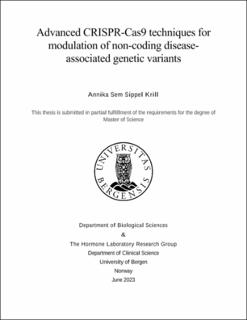| dc.description.abstract | The search for genetic explanations of individual susceptibility to complex polygenic diseases has greatly intensified in recent years, with GWAS studies having successfully linked several hundred thousand genomic loci to complex diseases. However, the disease mechanisms underlying these associations remain largely unknown due to several limitations of GWAS. In particular, since 90 % of identified disease-associated SNPs are located outside of protein-coding regions, their biological effects are largely unclear, and although they likely affect gene regulatory functions via altered DNA motifs for specific transcription factors, the target genes need to be identified. Furthermore, each locus contains up to several hundred SNPs in linkage disequilibrium, and thus the causal SNPs are unknown. Recent progress in addressing the problem has been made through the development of a more systematic approach involving several bioinformatic and experimental advances, that specifically tackles the mechanistic limitations of GWAS. The approach applies a series of methods to systematically narrow down the number of candidate causal SNPs, and ultimately identify the causal SNP and affected cell types, enhancers and gene regulatory mechanisms.. To experimentally validate causal SNPs in cellulo and establish downstream target genes and phenotypes, genome editing of the causal SNP must be performed. While regular CRISPR/Cas9 theoretically can be used for this purpose, it is highly inefficient and introduces several issues such as double-stranded breaks and potential off-target effects. In contrast, the newly developed Prime Editing (PE) technology may prove to be ideal for this type of precise genome editing. Furthermore, a second method, CRISPR/Cas9-mediated enhancer modulation (CA/I), may be used to strengthen the findings through direct epigenetic activation or repression of the enhancer in which the SNP resides. As a proof-of-concept study of these recent advances, this thesis builds upon previous unpublished work from our group, which identified a likely causal SNP (rs1799993) in an enhancer associated with visceral obesity, a particularly harmful type of fat accumulation. Epigenetic data suggested that the SNP affects an enhancer element that is active in adipose-derived mesenchymal stem cells (AD-MSCs). Thus, the current study has focused on establishing the genome editing tool PE for in situ editing of the SNP, as well as the epigenetic modulation system CA/I for modulation of the surrounding predicted enhancer element, for use in AD-MSCs. Spacers for sgRNAs and pegRNAs (the latter in PE) targeting the enhancer region and the SNP, respectively, were designed by in silico analysis, and evaluated in vitro for on-target efficiency. Extensions for pegRNAs were designed for editing the SNP from risk to protective allele and vice versa, and a plasmid library of the sgRNAs and pegRNAs was then prepared and sequence-validated. Furthermore, an appropriate mesenchymal stem cell (MSC) model was obtained and genotyped for the SNP in question. Because the MSCs are notoriously hard to transfect, comprehensive testing of transfection methods in these cells was performed, including a variety of chemical and physical methods of gene delivery. While the required plasmids for both PE and CA/I were successfully made, no transfection method proved successful in MSCs using the large-size PE plasmids. Consequently, the SNP rs1799993 was not edited. However, nucleofection was identified as the method that gave the best results in this cell type using smaller plasmids, thus suggesting that optimizations should be directed toward reducing the PE-plasmid size for successful use of this method is MSCs. For similar reasons, a pilot lentiviral transduction of plasmids for CRISPR activation/repression did not result in stably transduced MSCs. In summary, the work of this thesis has laid the groundwork for utilizing the PE and CA/I methods as tools to help translate GWAS association signals into causal gene regulatory mechanisms. Once optimized, the techniques should be able to determine whether rs1799993 is a causal SNP in the visceral obesity associated locus of interest, as well as identify the target genes of the enhancer where the SNP resides and alters transcription factor binding. | |
